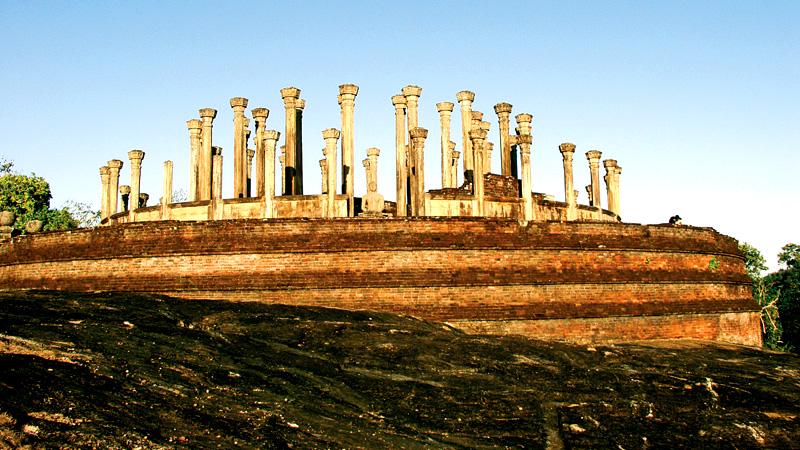
Having had our fill of Namal Pokuna in Dimbulagala, we moved on to our next destination, the magnificent architectural marvel known as the Medirigiriya Vatadage, on the outskirts of Polonnaruwa. This majestic creation is one of the few remaining Vatadages in Sri Lanka.
 Access to the Medirigiriya Vatadage is through a secondary road via Hingurakgoda, or rather we chose the secondary road to travel the 34 km from Polonnaruwa. The recent rains had painted the landscape green, filling the canals and tanks and making the paddy field lush.
Access to the Medirigiriya Vatadage is through a secondary road via Hingurakgoda, or rather we chose the secondary road to travel the 34 km from Polonnaruwa. The recent rains had painted the landscape green, filling the canals and tanks and making the paddy field lush.
Travelling through green fields flanking the road, we couldn’t help but wonder about the worrier Kings and what plans they would have devised in the bygone era to cultivate these vast stretches of fields to feed the people and make the country self-sufficient in its staple food: rice.
A circular relic house is surrounded by two or three rows of pillars of different height on which rested a cone-shaped roof to protect worshipers. The central stupa, framed by four statues of a meditating Buddha, was beneath the framework. The most beautiful Vatadage is in Medirigiriya.
Rocky outcrop
It was early evening when we reached the Medirigiriya archaeological site, and as if issuing a special welcome to us, the setting sun cast a smooth glow on the rocky outcrop, giving us a spectacular sight. The best time to visit the Vatadage is in the morning or evening by avoiding the harsh mid-day sun.
 Access to the Vatadage, atop a rocky boulder, is via a few short steps carved into a circular structure. The resting area is marked by tall rectangular columns. Another short climb brings you to the Vatadage, where the remains of guard stones on either side of the staircase still stand sentinel.
Access to the Vatadage, atop a rocky boulder, is via a few short steps carved into a circular structure. The resting area is marked by tall rectangular columns. Another short climb brings you to the Vatadage, where the remains of guard stones on either side of the staircase still stand sentinel.
There are three concentric rows of pillars (68) surrounding the four large rock cut statues of the Buddha in a seated position. A granite staircase leads to the platform, which is a common feature of this type of structure.
Traditionally, the circular shape stone structure called the Vatadage was constructed around a small stupa that enshrined the sacred relics of the Buddha, to provide protection and shelter. An earlier structure is believed to have existed here during the pre-Christian era. However, the Vatadage that remains today was built in the 7th Century by King Agbo IV and is considered one of the finest examples of this form of architecture. Later, many rulers are said to have contributed to the Vatadage and reconstructed the premises from time to time.
Polonnaruwa Kingdom
However, the Vatadage faced the same fate as the other sites elsewhere in Polonnaruwa when the rulers abandoned the kingdom due to invasions and shift of ruling seats. The Polonnaruwa Kingdom was deserted due to Chola invasion and the Vatadage was rediscovered in the 19th century.
Around the Stupa are three circles of stone pillars upon which the roof of the Vatadage was built. The inner-most circle consists of 16 pillars, while middle and outer circles contain 20 and 32 pillars. A circular wall made of bricks runs between the middle and outer circles, while a decorated stone wall is around the outermost circle. There are elaborate carvings on top of each pillar. From atop the circular platform, where the Vatadage stands, the view is dotted with the ruins of the structures, rocky outcrops and lush greenery.
Around the Vatadage are remnants of various structures each hinting at great significance and giving glimpses of a vast monastic complex. Ruins of a 3rd century image house stand on the right side of the Vatadage, with its collection of rock carved standing and seated Buddha statues. Ancient brick mouldings at the base of the Stupa have led some scholars to believe that this could have been a place of worship as early as the 1st century AD.
Ancient hospital
Close to the Vatadage are the ruins of what is believed to be an ancient hospital. Found here are ‘Beheth Oruwa’ (medical boat) and other medical equipment all carved in rock. The medicinal boat, usually filled with herbal medicines and used by ailing bhikkhus, was a common feature of ancient Sri Lankan hospitals and can be found in monastic complexes in ruined cities.
A few yards away from the Vatadage, there are, however, indications of attempts being made to destroy the rocky slabs, either by vandals or treasure hunters.
Some stone carved inscriptions and guard stones belonging to the Vatadage had been taken away by the villagers and were being used as grinding stones and for washing cloths, unaware of the importance of the ancient monuments.
Facing the Vatadage is another rocky boulder, on the summit of which lies the remains of a small brick Stupa. Stone steps carved on to the rock lead to the summit, which offers a spectacular view of a pond said to have been used by monastic bhikkhus in the past.
In the evening sun, the Vatadage, framed by the rustic pillar, looks somewhat different, both striking and soft and offers a picturesque view that appears to reflect its rich history and natural beauty.
